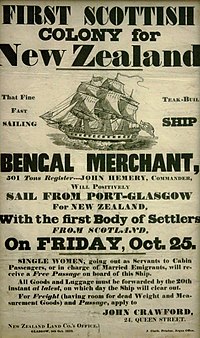This article needs additional citations for verification. (May 2022) |

Migration to New Zealand began only very recently in human history, with Polynesian settlement in New Zealand, previously uninhabited, about 1250 CE to 1280 CE. European migration provided a major influx, especially following the signing of the Treaty of Waitangi in 1840. Subsequent immigrants have come chiefly from the British Isles, but also from continental Europe, the Pacific, the Americas and Asia.
Given the isolation of the archipelago, people generally do not come to New Zealand casually: one cannot wander across a border or gradually encroach on neighbouring land in order to reach remote South Pacific islands. Settlement usually takes place deliberately, with waves of people transported from afar by successive boats or aeroplanes, and often landing in specific locales (rohe, colonies and provinces). This process results in relatively distinct groups of residents; nevertheless, repeated attempts have taken place to declare, define or meld such groups as a single common people or nation.